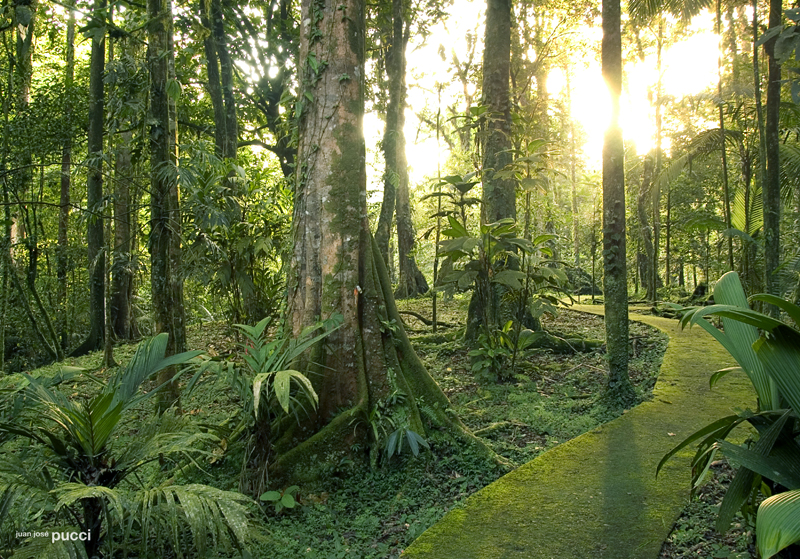La Selva’s Holdridge Arboretum made the grade
In June 2020, La Selva’s Holdridge Arboretum received accreditation as a Level II Arboretum from ArbNet, an international arboretum accreditation program dedicated to:
- Recognizing arboreta at various levels of development, capacity, and professionalism
- Fostering professionalism of arboreta worldwide
- Enabling collaboration in scientific, collections, and conservation activities
- Advancing the planting, study, and conservation of trees.
To put this achievement into perspective, there are currently only 122 arboreta world-wide with this level of accreditation out of 2,050 arboreta listed in the Morton Register of Arboreta. Those of you with ties to La Selva will know the “Arboleda” as a landscape on the SURA trail with many tagged trees and a cleared understory for ease of access. It is considered “an open classroom to facilitate the dendrological studies for hundreds of students and researchers visiting the station every year.” There are currently 929 individuals of 247 native species and 3 exotics, representing 63 families and 168 genera. This is the perfect setup for learning those important (and sometimes elusive) characteristics of the amazing diversity of La Selva’s trees.
Here is long-time researcher Gary Hartshorn’s description of how the Arboretum got started:
In order to provide a secure place for the NSF-funded comparative ecosystem research program, OTS purchased Finca La Selva from Dr. Leslie Holdridge in April 1968. I was invited to take a one-month, non-credit intensive field course in tropical dendrology (i.e., the field identification of trees) taught by Dr. Holdridge. The first two weeks of the dendrology course were devoted to learning tropical lowland trees of the seasonally dry forests of Guanacaste. We then moved to La Selva for the second half of the dendrology course. What a treat to go out each day to learn tropical trees from the premier dendrologist in Latin America. Dr. Holdridge gave us our final exam in an isolated cacao plantation with an exceptionally rich overstory of native trees. Afterward, as we reflected on the wonderful dendrology course and the difficult final exam, we agreed to recommend to OTS that this particular patch of cacao become a teaching arboretum. In October 1968, Gordon Frankie (post-doc with Herbert Baker) had the La Selva workers cut out the cacao trees in order to facilitate phenological observations of the tall trees.
I did the initial inventory of trees in the La Selva Arboretum in 1970–about 650 individuals representing 111 native tree species. During the early years, I added nearly 100 species to the Arboretum by collecting local seed or seedlings. OTS’ outstanding naturalist, Orlando Vargas, has taken care of the Arboretum for the past 30+ years (Vargas & Castro 2018). The 3.5-hectare arboretum was designated the Holdridge Arboretum in 1978 to honor this great tropical forester.
Vargas, O. and E. Castro. 2018. See Holdridge Arboretum PDF. Organization for Tropical Studies La Selva Biological Station.
Source of quotation above: Hartshorn, G. S. 2020. Chronicles of a Tropical Treeologist. 338 pages. In Press.
The Arboretum is an open classroom in many ways in addition to its value for learning tropical tree characteristics. Hundreds of OTS field projects have been based on the plants, animals, soils, and processes in this 3.5 hectare patch of land; and every course coordinator can tell their own particular stories about time spent here with students. Deedra McClearn, another long-time researcher and former Director of La Selva, states, “In my experience, the Arboretum is the perfect place to net some of the 70+ species of bats during the evening hours. A clothesline strung between two posts of the covered pavilion provides a dry place to hang the resting bats in their little cloth bags, while students sit on benches to measure and key out the bats before releasing them.”
The understory is also a fern-lover’s paradise with a beautiful carpet of maidenhair ferns (Adiantum spp.) gracing the site in between the weed-whacking forays of the station groundkeepers. It is said that the nests of the bullet ant (Paraponera clavata) are about 10 meters apart in this landscape, so one must maintain a certain level of alertness to one’s surroundings.
The effort to accredit the Holdridge Arboretum was accomplished by Orlando Vargas, Encargado de operaciones científicas, and Enrique Castro, Encargado de datos para investigatión, with support from many associates. They have been working for years, maintaining the data registry and remeasuring the trees on a regular basis. They envision adding even more tree species in the future – up to La Selva’s 420 species! They encourage students and researchers to take advantage of this unique resource, even as they plan how to move the Holdridge Arboretum to Level III accreditation.
To paraphrase a famous author, “It’s not [only] about what it is; it’s [also] about what it can become.” – Dr. Seuss, The Lorax

